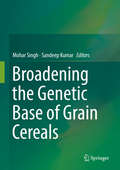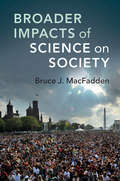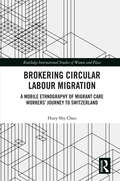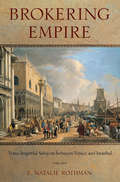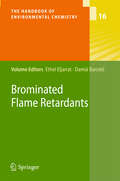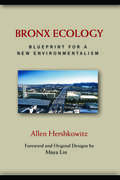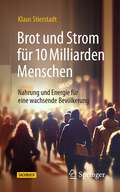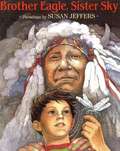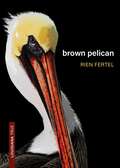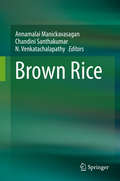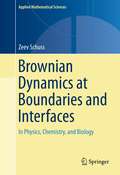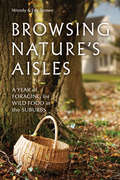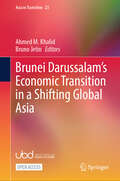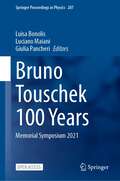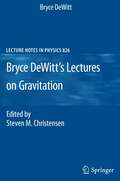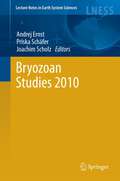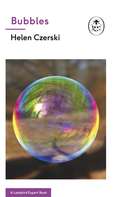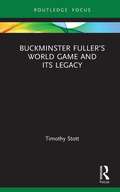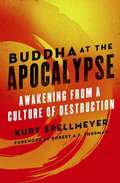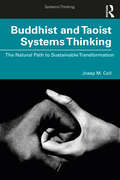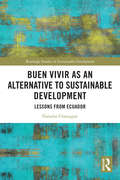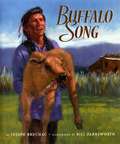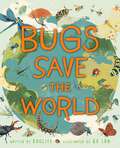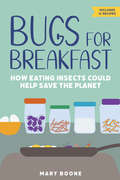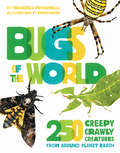- Table View
- List View
Broadening the Genetic Base of Grain Cereals
by Sandeep Kumar Mohar SinghThis book offers comprehensive coverage of important grain cereals including their origin and distribution, crop gene pool, level of diversity, production constraints, traits of importance for genetic base widening, crop improvement methodologies, genome mapping, genomics for breeding, and future strategies. The chapters, contributed by eminent crop researchers from around the world, provide rare insights into the crop-specific constraints and prospects drawing from their substantial experience. As such, the book offers an essential source of information for grain cereals scientists, teachers, students, policy planners and developmental experts alike. Grain cereals, which comprise rice, wheat, maize, barley, oats, sorghum and millets, are members of the grass family. These crops are vital to human nutrition, thanks to their roles as staple food crops in different parts of the globe. Some of them are rich sources of carbohydrates, which provide energy, while others are important sources of minerals, vitamins and proteins, in addition to their medicinal properties. In most cereals, the existing variability among elite germplasm has been exploited to attain a desirable level of productivity. However, to make further breakthroughs in enhancing yield and improving stability in future crop cultivars, new sources of genes/alleles need to be identified in wild/weedy species and incorporated into the cultivated varieties. Though there have been many publications on various aspects of grain cereal improvement in the recent past, to date this essential information has remained scattered among different periodicals.
Broader Impacts of Science on Society
by Bruce J. MacFaddenHow do scientists impact society in the twenty-first century? Many scientists are increasingly interested in the impact that their research will have on the public. Scientists likewise must answer the question above when applying for funding from government agencies, particularly as part of the 'Broader Impacts' criterion of proposals to the US National Science Foundation. This book equips scientists in all disciplines to do just that, by providing an overview of the origins, history, rationale, examples, and case studies of broader impacts, primarily drawn from the author's experiences over the past five decades. Beyond including theory and evidence, it serves as a 'how to' guide for best practices for scientists. Although this book primarily uses examples from the NSF, the themes and best practices are applicable to scientists and applications around the world where funding also requires impacts and activities that benefit society.
Brokering Circular Labour Migration: A Mobile Ethnography of Migrant Care Workers’ Journey to Switzerland (Routledge International Studies of Women and Place)
by Huey Shy ChauThis book examines the commercialisation of domestic and care work through private agencies that organise transnational care arrangements by brokering migrant workers. The book focuses on the emergence of private for-profit home care agencies following the 2011 extension of the Free Movement of Workers to Eastern European Countries agreement in Switzerland. The agencies recruit migrant women from these countries and place them in private households for elderly care. This book explores how circular labour migration for these care workers is facilitated. In the form of a mobile ethnography, it traces their journey from Eastern European countries to Switzerland – from when care workers find employment and are recruited by agencies to when they arrive at their designated households. From the agencies’ analytical standpoint, the book examines the recruitment and placement practices of the home care agencies and their role in facilitating migration. Brokering Labour Migration offers an understanding of new migration patterns and highlights fundamental changes in migration control with the extension of free movement of workers in Switzerland to lower-wage countries in Eastern Europe. It will be an invaluable resource for academics and scholars of geography, anthropology, sociology, and gender and migration.
Brokering Empire: Trans-Imperial Subjects between Venice and Istanbul
by E. Natalie RothmanIn Brokering Empire, E. Natalie Rothman explores the intersecting worlds of those who regularly traversed the early modern Venetian-Ottoman frontier, including colonial migrants, redeemed slaves, merchants, commercial brokers, religious converts, and diplomatic interpreters. In their sustained interactions across linguistic, religious, and political lines these trans-imperial subjects helped to shape shifting imperial and cultural boundaries, including the emerging distinction between Europe and the Levant.Rothman argues that the period from 1570 to 1670 witnessed a gradual transformation in how Ottoman difference was conceived within Venetian institutions. Thanks in part to the activities of trans-imperial subjects, an early emphasis on juridical and commercial criteria gave way to conceptions of difference based on religion and language. Rothman begins her story in Venice's bustling marketplaces, where commercial brokers often defied the state's efforts both to tax foreign merchants and define Venetian citizenship. The story continues in a Venetian charitable institution where converts from Islam and Judaism and their Catholic Venetian patrons negotiated their mutual transformation. The story ends with Venice's diplomatic interpreters, the dragomans, who not only produced and disseminated knowledge about the Ottomans but also created dense networks of kinship and patronage across imperial boundaries. Rothman's new conceptual and empirical framework sheds light on institutional practices for managing juridical, religious, and ethnolinguistic difference in the Mediterranean and beyond.
Brominated Flame Retardants (The Handbook of Environmental Chemistry #16)
by Damià Barceló Ethel EljarratBrominated flame retardants are one of the last classes of halogenated compounds that are still being produced worldwide and used in large quantities in many applications. They are used in plastics, textiles, electronic circuitry, and other materials to prevent fires. This volume covers the state-of-the-art of the analysis, fate and behaviour of brominated flame retardants. Experts in the field provide an overview of the compounds' physico-chemical properties and uses, their occurrence in the environment and biota, advanced chemical analytical methods, degradation studies, toxicological effects and human exposure. This book is a valuable and comprehensive source of information for environmental scientists interested in brominated flame retardant issues, and for authorities and producers.
Bronx Ecology: Blueprint for a New Environmentalism
by Maya Lin Allen HershkowitzIn Bronx Ecology, Hershkowitz tells the story of the Bronx Community Paper Company from its earliest inception to its final demise nearly ten years later.
Brot und Strom für 10 Milliarden Menschen: Nahrung und Energie für eine wachsende Bevölkerung
by Klaus StierstadtWie lange liefert die Sonne genug Energie für unsere wachsende Bevölkerung?Reichen unsere Dächer aus, um ausreichend Solarstrom zu erzeugen?Stellen Pflanzen und Algen genug Nahrung und Sauerstoff für alle Lebewesen bereit?Millionen Menschen hungern. Strom ist für Milliarden Menschen ein Traum oder zumindest ein Luxusgut. Diese Buch diskutiert mit Hilfe verständlich dargestellter Physik wie weit es zu wenig Ressourcen gibt und wie weit es schlicht eine Problem der Verteilung ist.Das Buch ist gleichermaßen geeignet für Interessierte wie für Personen mit physikalischer Ausbildung. Zahlreiche Vergleiche und Erklärungen zeichnen ein anschauliches Bild, welches durch zahlreiche Abschätzungen und physikalische Details ergänzt wird.
Brother Eagle, Sister Sky: A Message from Chief Seattle
by Chief Seattle Susan JeffersFrom the Book jacket: How can you buy the sky? How can you own the rain and the wind? So began the moving words attributed to a great American Indian chief over one hundred years ago. They are words that eloquently and poetically captured the central belief of Native Americans: that this earth and every creature on it is sacred. It is these words and this belief that have inspired what has been truly a labor of love for Susan Jeffers; her most extraordinary paintings illuminate the words and world vision possessed by Native Americans. Brother Eagle, Sister Sky will haunt all who see it with its portrayal of what has been lost in our world, and is an important message to people young and old to care for and preserve the environment. CHIEF SEATTLE lived from approximately 1790 to 1866, in the Pacific Northwest region of what is now the United States. He was a chief of the Suquamish and the Duwamish Indians and was present at treaty negotiations that took place with the dominant white settlers in the 1850s. It is at one of these negotiations that Chief Seattle delivered a speech in his native tongue, a speech which has since- in a variety of forms-served as the basis of ecological movements around the world and from which Brother Eagle, Sister Sky is drawn. Susan Jeffers is internationally acclaimed for her exquisite paintings, and the illustrator of numerous picture books for Dial-all of which brilliantly portray nature. Ms. Jeffers' paintings are beautifully described.
Brown Pelican (Louisiana True)
by Rien FertelIn this compelling book, Rien Fertel tells the story of humanity’s complicated and often brutal relationship with the brown pelican over the past century. This beloved bird with the mythically bottomless belly—to say nothing of its prodigious pouch—has been deemed a living fossil and the most dinosaur-like of creatures. The pelican adorns the Louisiana state flag, serves as a religious icon of sacrifice, and stars in the famous parting shot of Jurassic Park, but, most significantly, spotlights our tenuous connection with the environment in which it flies, feeds, and roosts—the coastal United States. In 1903, Theodore Roosevelt inaugurated the first national wildlife refuge at Pelican Island, Florida, in order to rescue the brown pelican, among other species, from the plume trade. Despite such protections, the ubiquity of synthetic “agents of death,” most notably DDT, in the mid-twentieth century sent the brown pelican to the list of endangered species. By the mid-1960s, not one viable pelican nest remained in all of Louisiana. Authorities declared the state bird locally extinct. Conservation efforts—including an outlandish but well-planned birdnapping—saved the brown pelican, generating one of the great success stories in animal preservation. However, the brown pelican is once again under threat, particularly along Louisiana’s coast, due to land loss and rising seas. For centuries, artists and writers have portrayed the pelican as a bird that pierces its breast to feed its young, symbolizing saintly piety. Today, the brown pelican gives itself in other ways, sacrificed both by and for the environment as a bellwether bird—an indicator species portending potential disasters that await. Brown Pelican combines history and first-person narrative to complicate, deconstruct, and reassemble our vision of the bird, the natural world, and ourselves.
Brown Rice
by Annamalai Manickavasagan Chandini Santhakumar N. VenkatachalapathyThis book provides a broad-based foundation of knowledge about brown rice, including the latest information on health benefits and disease prevention resulting from consumption of brown rice, and information on consumer knowledge, attitudes, and behaviors towards brown rice. It is the first book of its kind to provide a comprehensive review of current brown rice science and technology, regulatory/policy issues, dietary intake, consumer interest and health promotion. The edited volume focuses on the latest developments in breeding varieties for high quality brown rice, varietal variations, defects, milling, cooking quality, eating quality, post-harvest management and methods to improve shelf life. Contributing authors address the physical, chemical, engineering, nutritional and glycemic qualities of brown rice in different chapters. Authors also discuss the physiological functions of brown rice in vivo and radical scavenging activity, emphasizing their impo rtance to growers, technologists and consumers, and providing insight into future advances. This comprehensive collection benefits scientists, nutritionists, dieticians, diabetic educators, and professionals in the food industry. The information covered is valuable for food scientists and technologists working to develop new brown rice products and enhancing the taste, quality, and health profile of brown rice.
Brownian Dynamics at Boundaries and Interfaces: In Physics, Chemistry, and Biology (Applied Mathematical Sciences #186)
by Zeev SchussBrownian dynamics serve as mathematical models for the diffusive motion of microscopic particles of various shapes in gaseous, liquid, or solid environments. The renewed interest in Brownian dynamics is due primarily to their key role in molecular and cellular biophysics: diffusion of ions and molecules is the driver of all life. Brownian dynamics simulations are the numerical realizations of stochastic differential equations that model the functions of biological micro devices such as protein ionic channels of biological membranes, cardiac myocytes, neuronal synapses, and many more. Stochastic differential equations are ubiquitous models in computational physics, chemistry, biophysics, computer science, communications theory, mathematical finance theory, and many other disciplines. Brownian dynamics simulations of the random motion of particles, be it molecules or stock prices, give rise to mathematical problems that neither the kinetic theory of Maxwell and Boltzmann, nor Einstein's and Langevin's theories of Brownian motion could predict.This book takes the readers on a journey that starts with the rigorous definition of mathematical Brownian motion, and ends with the explicit solution of a series of complex problems that have immediate applications. It is aimed at applied mathematicians, physicists, theoretical chemists, and physiologists who are interested in modeling, analysis, and simulation of micro devices of microbiology. The book contains exercises and worked out examples throughout.
Browsing Nature's Aisles: A Year of Foraging for Wild Food in the Suburbs
by Wendy Brown Eric BrownThis guide to suburban foraging shares the “inspiring journal of one family’s effort to break free from manufactured foods and transition to . . . wild fare” (Thomas J. Elpel, author, Botany in a Day).As part of their commitment to increasing self-reliance and resiliency, Wendy and Eric Brown decided to spend a year incorporating wild edibles into their regular diet. Their goal was to use native flora and fauna to help bridge the gap between what their family could produce and what they needed to survive. The experience fundamentally changed their definition of food.Packed with a wealth of information on collecting, preparing, and preserving easily identifiable wild edibles found in most suburban landscapes, Browsing Nature s Aisles is the story of one suburban family s adventures in wild foraging. This unique and inspiring guide is a must-read for those who wish to enhance their food security by availing themselves of the cornucopia on their doorstep.
Brunei Darussalam’s Economic Transition in a Shifting Global Asia (Asia in Transition #23)
by Bruno Jetin Ahmed M. KhalidThis is an Open Access book. The international political economy is confronted by a number of overlapping crises. These include the climate emergency, rapid technological advancement, the high volume of globalised trade and financial flows, cross-border labour movement, rising inequality, geopolitical tensions, and frequent economic crises and natural disasters. Many developing countries are going through a period of urgent transformation and transition to adopt new policies to cope with such challenges and achieve and maintain sustainable and inclusive socioeconomic development. This path-breaking volume explores the issues shaping the response of Brunei Darussalam, long dependent on its oil and gas sector, to these challenges. The discussions presented here are framed by the notion of ‘development in transition’—a mix of well-designed policies driven by timely implementation, enforcement and monitoring, as well as international cooperation to ensure sustainable development and distribution of benefits on an equitable basis. Through fine-grained analyses of key economic sectors—including natural resources, employment patterns, financial services, global value chains, international trade, tourism and the role of the public sector—the contributors offer a critical assessment of Brunei’s policy responses. This transitional policy mix is situated in relation to the overarching development strategy called Wawasan Brunei 2035 (Brunei Vision 2035), which broadly maps onto the United Nations 2030 Agenda for Sustainable Development Goals. Academic scholars, university students and others interested in the study of contemporary Brunei and broader questions of economic transition in Asia will find this volume an invaluable resource for a deeper understanding of how development paths and priorities are being managed to meet pressing global and local challenges.
Bruno Touschek 100 Years: Memorial Symposium 2021 (Springer Proceedings in Physics #287)
by Luciano Maiani Luisa Bonolis Giulia PancheriThis open access book celebrates the contribution of Bruno Touschek to theoretical physics and particle colliders in Europe. It contains direct testimonials from his former students, collaborators, and eminent scientists, among them, two Nobel Prize winners in Physics, Giorgio Parisi and Carlo Rubbia. It reviews the main developments in theoretical and accelerator physics in the second half of the twentieth century, while at the same time providing an overview of future prospects worldwide. This book is unique in that it will be of interest to historians of physics and also to the younger generation of researchers. Through the contribution of the leading protagonists, the interested scholar will learn about the past, present status, and relevance of both theoretical and experimental accelerator physics. The overview of Bruno Touschek’s life and works across Europe, from pre-war Vienna to Germany, the UK, Italy, and France, adds a human dimension to the scientific narration, while the open access status makes this laudatory book available to anyone with interest.
Bryce DeWitt's Lectures on Gravitation: Edited by Steven M. Christensen (Lecture Notes in Physics #826)
by Steven M. Christensen Bryce DewittBryce DeWitt, a student of Nobel Laureate Julian Schwinger, was himself one of the towering figures in 20th century physics, particularly renowned for his seminal contributions to quantum field theory, numerical relativity and quantum gravity. In late 1971 DeWitt gave a course on gravitation at Stanford University, leaving almost 400 pages of detailed handwritten notes. Written with clarity and authority, and edited by his former student Steven Christensen, these timeless lecture notes, containing material or expositions not found in any other textbooks, are a gem to be discovered or re-discovered by anyone seriously interested in the study of gravitational physics.
Bryozoan Studies 2010 (Lecture Notes in Earth System Sciences #143)
by Andrej Ernst Joachim Scholz Priska SchäferBryozoa are a colonial animal phylum with a long evolutionary history, having existed from the early Ordovician (480 My) onward and still flourishing today. Several mass extinctions in earth history shaped and triggered bryozoan evolution through drastic turnover of faunas and new evolutionary lineages. Bryozoa are widespread across all latitudes from Equator to Polar Regions and occur in marine and freshwater environments. They are shaping benthic ecosystems and recording ambient environmental conditions in their skeletons. The book provides a synthesis of the current main topics of research in the field of Bryozoology including combined research on both extant, and extinct taxa. Fields or current research span molecular genetics and phylogeny, life history, reproduction and anatomy, biodiversity and evolutionary patterns in time and space, taxonomy, zoogeography, ecology, sediment interactions, and climate response.
Bubbles: A Ladybird Expert Book (The Ladybird Expert Series #24)
by Helen CzerskiPart of the new Ladybird Expert series, Bubbles is a clear, surprising and entertaining introduction to the science of bubbles. Bubbles are beautiful, ephemeral, fun, fragile, jolly and slightly unpredictable. We're all familiar with them, but we don't often ask what they actually are. The great scientists of the Western world - Robert Hooke, Isaac Newton, Lord Rayleigh and more - studied bubbles seriously. They recognised that they had a lot to say about the nature of the physical world, and they poked, prodded and listened to find out what it was. In the years since, we've learned that this bulbous arrangement of liquid and gas does things that neither the gas or the liquid could do by itself. Written by the celebrated physicist and oceanographer Helen Czerski, Bubbles explores how everything from the way drinks taste to the Earth's temperature are influenced by bubbles. This book has a message: never underestimate a bubble!Written by the leading lights and most outstanding communicators in their fields, the Ladybird Expert books provide clear, accessible and authoritative introductions to subjects drawn from science, history and culture.For an adult readership, the Ladybird Expert series is produced in the same iconic small hardback format pioneered by the original Ladybirds. Each beautifully illustrated book features the first new illustrations produced in the original Ladybird style for nearly forty years.
Buckminster Fuller’s World Game and Its Legacy (Routledge Focus on Art History and Visual Studies)
by Timothy StottThis book studies R. Buckminster Fuller’s World Game and similar world games, past and present. Proposed by Fuller in 1964 and first played in colleges and universities across North America at a time of growing ecological crisis, the World Game attempted to turn data analysis, systems modelling, scenario building, computer technology, and information design to more egalitarian ends to meet human needs. It challenged players to redistribute finite planetary resources more equitably, to ‘make the world work’. Criticised and lauded in equal measure, the World Game has evolved through several formats and continues today in correspondence with debates on planetary stewardship, gamification, data management, and the democratic deficit. This book looks again at how the World Game has been played, focusing on its architecture, design, and gameplay. With hindsight, the World Game might appear naïve, utopian, or technocratic, but we share its problems, if not necessarily its solutions. Such a study will be of interest to scholars working in art history, design history, game studies, media studies, architecture, and the environmental humanities.
Buddha at the Apocalypse
by Kurt Spellmeyer Robert ThurmanTimely and audacious, Buddha at the Apocalypse challenges us to look directly at the devastating assumptions underlying the very mechanisms of the modern world - and offers a clarion call to awaken from a pervasive culture of destruction into a natural, sustainable, and sane peace. Kurt Spellmeyer references the Bible, popular culture, Zen, and Western philosophy in addressing two questions: how did we get here, and what can we do now. An answer to pervasive cynicism and decline, Buddha at the Apocalypse shows how to accept and connect with reality in dark times.
Buddhist and Taoist Systems Thinking: The Natural Path to Sustainable Transformation (Systems Thinking)
by Josep M. CollBuddhist and Taoist Systems Thinking explores a radical new conception of business and management. It is grounded on the reconnection of humans with nature as the new competitive advantage for living organizations and entrepreneurs that aspire to regenerate the economy and drive a positive impact on the planet, in the context of the Anthropocene. Organizations today struggle in finding a balance between maximizing profits and generating value for their stakeholders, the environment and the society at large. This happens in a paradigm shift characterized by unprecedented levels of exponential change and the emergence of disruptive technologies. Adaptability, thus, is becoming the new business imperative. How can, then, entrepreneurs and organizations constantly adapt and, at the same time, design the sustainable futures they’d like? This book uniquely explores the benefits of applying Buddhist and Taoist Systems Thinking to sustainable management. Grounded in Taoist and Zen Buddhist philosophies, it offers a modern scientific perspective fundamentally based on the concepts of bio-logical adaptability and lifefulness amidst complexity and constant change. The book introduces the new concept of the Gaia organization as a living organism that consciously helps perpetuate the conditions for life on the planet. It is subject to the natural laws of transformation and the principles of oneness, emptiness, impermanence, balance, self-regulation and harmonization. Readers will find applied Eastern systems theories such as the Yin-Yang and the Five Elements operationalized through practical methodologies and tools such as T-Qualia and the Zen Business model. They are aimed at guiding Gaia organizations and entrepreneurs in leading sustainable transformations and qualifying economic growth. The book offers a vital toolkit for purpose-driven practitioners, management researchers, students, social entrepreneurs, evaluators and change-makers to reinvent, create and mindfully manage sustainable and agile organizations that drive systemic transformation.
Buen Vivir as an Alternative to Sustainable Development: Lessons from Ecuador (Routledge Studies in Sustainable Development)
by Natasha ChassagneUntil recently, the concept of Buen Vivir has only been loosely articulated by practising communities and in progressive policy in countries like Ecuador. What it actually means has been unclear, and in the case of policy, contradictory. As such there has been a lack of understanding about exactly what Buen Vivir entails, its core principles and how to put it into practice. This book, based on extensive theoretical and field research of Buen Vivir as an alternative to sustainable development, fills that gap and offers a concrete way forward. It uses an ethnographic study in the Cotacachi County of Ecuador's highlands communities to explore how communities understand and practice Buen Vivir. Combining this with what we already know about the concept theoretically, the book then develops a framework for Buen Vivir with 17 principles for practice. Exploring Buen Vivir’s evolution from its indigenous origins, academic interpretations and implications for development policy; to its role in endogenous, community-led change, this book will be of interest to policymakers, and development professionals. It will also be of great value to activists, students and scholars of sustainability and development seeking grassroots social and environmental change.
Buffalo Song
by Joseph BruchacHetcha hey Hetcha ho Hetcha hey yeh ho Walking Coyote gently lifted the frightened buffalo calf and sang softly. <P><P> Lone survivor of a herd slaughtered by white hunters, the calf was one of several buffalo orphans Walking Coyote adopted and later raised on the Flathead Indian Reservation in Montana. For thousands of years massive herds of buffalo roamed across much of North America, but by the 1870s fewer than fifteen hundred animals remained. Hunted to the brink of extinction, the buffalo were in danger of vanishing. With reverent care, Walking Coyote and his family endeavored to bring back the buffalo herds, one magnificent creature at a time. Here is the inspiring story of the first efforts to save the buffalo, an animal sacred to Native Americans and a powerful symbol of the American West. From the foresight and dedication of a few individuals such as Walking Coyote came the eventual survival of these majestic animals, one of the great success stories of endangered species rescue in United States history.
Bugs Save the World
by BuglifeFind out why bugs are so important - to humans, animals and the survival of our planetOur amazing bugs are in trouble. Without bugs, plants would not be able to make flowers or fruit. If bugs disappeared, so would strawberries, apples, beans and tomatoes, and even chocolate. Without them, we couldn't grow enough food to feed us all. If we lost bugs, we would also lose creatures who depend on them for survival, such as songbirds, badgers, bats and fish.Written by the conservation charity Buglife, this book shows the reasons why bugs are so important - to humans, animals and the survival of our planet. Discover bugs in all shapes, sizes and colours, and learn how these tiny creatures are going to help SAVE the world. You can also discover what you can do to help protect bugs. Buglife, the Invertebrate Conservation Trust, is dedicated to protecting insects, bugs and all invertebrate species.This book supports science work in schools by looking at different animals, adaptation, food chains, life cycles, habitats and climate change.In the accompanying book, Plants Save the World, you can discover why plants are vitally important to the survival of our planet, too!
Bugs for Breakfast: How Eating Insects Could Help Save the Planet
by Mary BooneMost North Americans would rather squish a bug than eat it. But roasted grubs are a favorite in Australia, the Batswana eat live termites, and stir-fried dragonflies are a delicacy in Indonesia. More than one-fourth of the world's population eats insects—a practice called entomophagy. Bugs for Breakfast helps middle-grade readers understand the role insects fill in feeding people around the world. Readers will be introduced to the insect specialties and traditions of various countries. They'll discover how nutritious bugs can be and why dining on insects is more environmentally friendly than eating traditional protein sources. Kids will see how making small changes in their own diets could help ensure no one goes hungry. It even includes 12 insect recipes! No doubt about it: teachers, librarians, and parents are hungry for books that entice young readers to be active participants in science.Bugs for Breakfast may not completely remove the yuck-factor from the notion of eating bugs, but it will open young readers' minds to what is happening in the world around them.
Bugs of the World: 250 Creepy-Crawly Creatures from Around Planet Earth
by Francesco TomasinelliFrom moths and beetles to worms and spiders, this completely illustrated, fact-filled book features hundreds of creepy-crawlies for kids to discover and explore.This gorgeously illustrated book reveals the hidden world of some of the most mind-boggling insects. Divided into categorical sections like herbivores and predators, Bugs of the World includes beetles, wasps, bees, ants, caterpillars, butterflies, dragonflies, spiders, flies, crickets and grasshoppers, centipedes and millipedes, and more. Each of the 250 insects featured is accompanied by beautiful illustrations and facts about the creature, including its common name and scientific name, its size, its continent of origin, and a brief description of its unique characteristics. Kids will also learn about the different life cycles of insects, why they are important to ecology and our world, the planet's most dangerous insects, how bugs camouflage themselves, and so much more.
